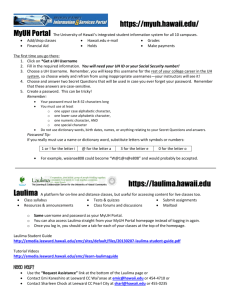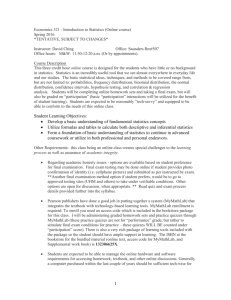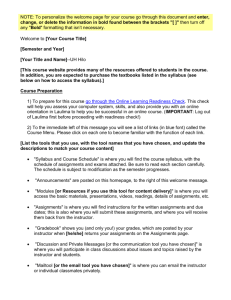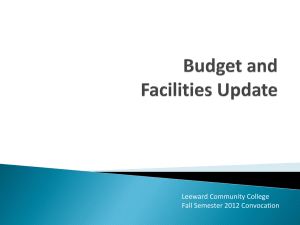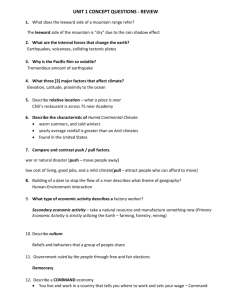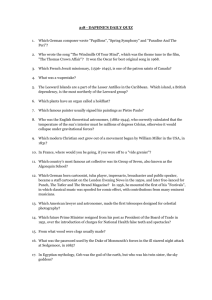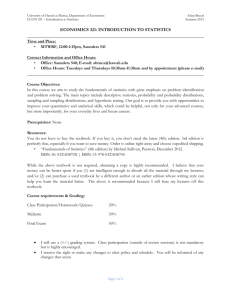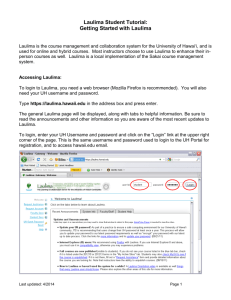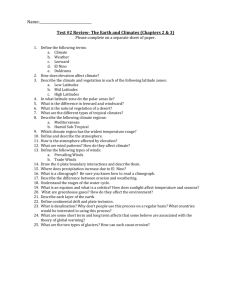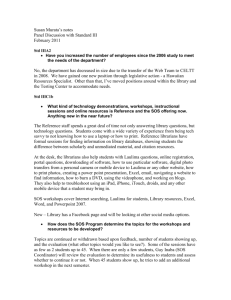Substantive Change Proposal
advertisement
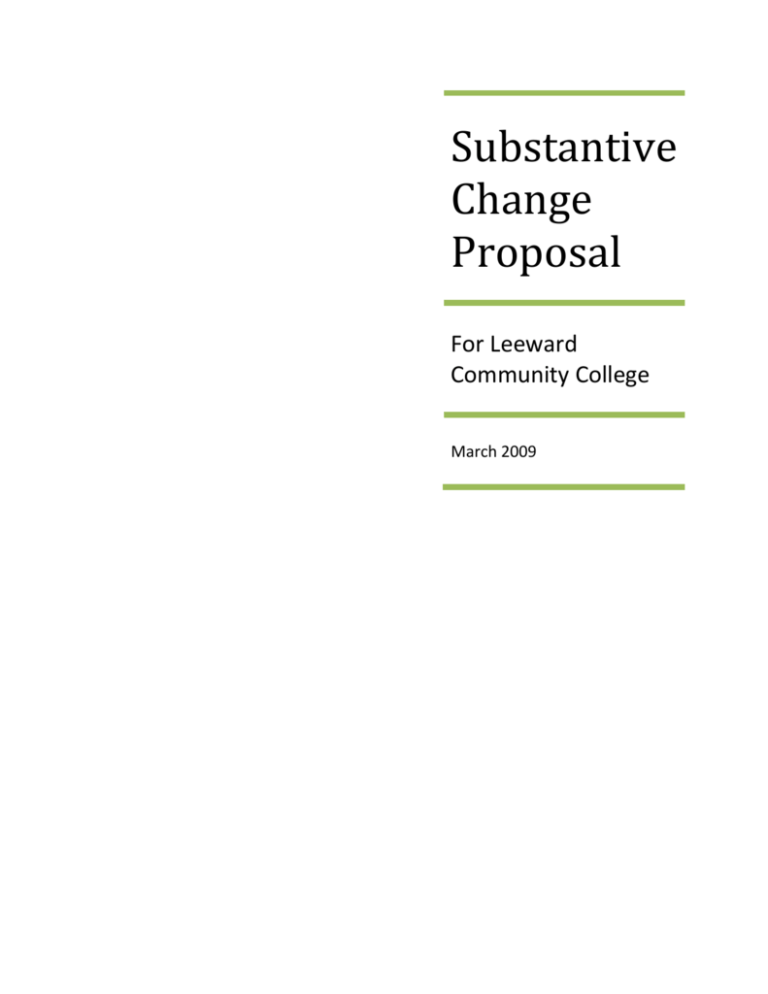
Substantive Change Proposal For Leeward Community College March 2009 Table of Contents 2 Background Information Leeward Community College (Leeward CC) is one of the 10 campuses in the University of Hawai‘i System. The University of Hawai‘i System includes dozens of educational, training and research centers across the Hawaiian Islands. As the public system of higher education in Hawai‘i, UH offers opportunities as unique and diverse as our Island home. Leeward CC, located on the island of O‘ahu, opened its doors in the Fall of 1968 as the first Community College in the State developed without a connection to a pre-existing technical school. With a mission based on the recognition of the diversity of the communities it serves, and on the belief in the dignity and potential of each individual to learn, the College was the first post-secondary institution in West O‘ahu. In 1968, Leonard T. Tuthill, our first Provost, welcomed over 1,640 students into humble old buildings that once housed Pearl City Kai Elementary School. That first semester witnessed more than twice the anticipated number of students ready to explore the “Community 3 College” experience. In the spring of 1969, the College moved to its current location, on forty nine acres near the geographic center of O‘ahu between Pearl City and Waipahu. Since those beginnings in inauspicious temporary facilities, enrollment has grown to place the College as the second largest community college in the State and the third largest campus within the UH system. Enrollment growth has been robust, with Leeward CC posting the largest numerical gain in enrollment in the UH system in both fall 2008 and spring 2009 semesters. Approximately 6,000 students are regularly enrolled each semester in liberal arts and career and technical education programs offered on campus, at off-campus locations in the community, and through distance education courses. Combined with the nearly 10,000 students in continuing education programs, the College serves as the educational focal point for the Leeward and Central O‘ahu regions The last buildings at Leeward were completed in the late seventies, and as the College celebrates its fortieth anniversary, the infrastructure is showing its age. Still, the architectural design has proven very flexible. The growth of technology has been accommodated through major upgrades in electrical capacity and installation of comprehensive wired and wireless networking. Major physical renovations have been made to the Student Center. A capitol improvement project is in the works to renovate the existing 3-story Library Building into a Learning Commons. Leeward CC is in the planning and design process of its new building since the College was completed. Leeward CC is committed to serving the residents of the communities of Leeward and Central O‘ahu in particular, and the State in general, by providing balanced and comprehensive programs, services, and educational opportunities. To achieve this end, the College must know its students, their needs, their educational goals, and the effectiveness of its programs and services in meeting these needs and goals. In 2005, Leeward Community College instituted a comprehensive, data-driven Program Review process that uses demographic information on the diverse communities it serves along side data on student achievement and learning. This 4 process generates a prioritized College plan that serves as the basis for improvements in addressing the College’s mission. The UH System, in an effort to provide a data for long range planning, recently updated its Second Decade project, a comprehensive data analysis of the state’s educational needs. Of the four top regions in the state with the greatest needs for higher education resources, three are in Leeward CC’s service area. This area is also predicted to have the largest population growth of any in the state. The college is pursuing partnerships with business to develop tailored programs that can be quickly deployed and provide for cost sharing opportunities. The College has recently received funding to prototype this approach for applied science and technology programs such as training in chemical technology—particularly appropriate for a College that has a long history of innovation in chemistry teaching. Another emerging program of note is the Associate in Arts in Teaching degree. Enrollment in the Teacher Education Program has grown ten-fold, from 24 students in the fall of 2006 to more than 250 students in spring of 2008. Articulation agreements between Leeward and UHM, UHWO and Chaminade make this a highly sought after program for our students. Description of the Proposed Change Early in the 1990s, the University of Hawai‘i Community College system made a commitment to increase access to all students in the state by encouraging each of the seven campuses to contribute courses to a distance-delivered Associate in Arts (AA) degree. It has, thus, been possible for a number of years for any student in the system to earn an AA degree via distance education by combining courses from various campuses. Leeward CC is requesting a substantive change based on “change in the courses or programs or their mode of delivery that represents a significant departure from current practices”. With the rise in the development of online courses, it is possible for a student at Leeward CC to almost earn an AA degree. Leeward CC is requesting substantive change for the following 5 degrees and certificates: Each of them allow students to earn 50% or more of the requirements via distance: Associate in Arts (AA) degree Associate in Arts in Teaching Degree Academic Subject Certificate ACCOUNTING Academic Subject Certificate Business Academic Subject Certificate BUSINESSTECHNOLOGY Academic Subject Certificate Information & Computer Science Academic Subject Certificate Management Academic Subject Certificate Writing Business Track Certificate of Completion in Small Business Accounting Certificate of Achievement Accounting Associate in Science Degree Accounting Certificate of Completion Medical Receptionist Certificate of Completion Business Technology Associate in Science Degree Business Technology Certificate of Competence Business Foundations Certificate of Competence Management Foundations Certificate of Competence Retail Foundations Certificate of Completion Business Essentials Associate in Applied Science Degree in Supervisory Management Certificate of Completion in Basic Networking Certificate of Completion Help Desk Associate in Science Degree Information & Computer Science Leeward CC offers students the ability to earn 50% or more of their credit hours required through completely online instruction. The asynchronous nature of online instruction is the most obvious and significant component of the change. To accommodate this change, the college provides professional development workshops and training for instructors and technical support for instructors and students. The second component of the proposed change is in the way that educational support services are delivered. Distance learning students require the same sorts of educational support services as traditional on-campus students. Leeward CC has adapted many of these services to provide 6 remote access for distance learning students. These adaptations also benefit traditional students. Support services such as library and learning resources (tutoring), helpdesk, and technical support for instructors and students may now be accessed electronically from remote sites. LCC is still working on adapting services such as admissions and records, financial aid, personal and career counseling, academic advising, and fee payment to be accessed from remote sites. Please see section on Evidence of sufficient support staffing below. Mission As one of the seven community colleges of the University of Hawai‘i, the overall mission of Leeward Community College is contained in the following principles. Access To broaden access to postsecondary education in Hawai‘i, regionally, and internationally by providing open-door opportunities for students to enter quality educational programs within their own communities. Learning and Teaching To specialize in the effective teaching of remedial/developmental education, general education, and other introductory liberal arts, preprofessional, and selected baccalaureate courses and programs, with the goal of seamless system articulation and transfer, where appropriate. To structure our programs in such a way that they reflect not only academic rigor but also student development, learning outcomes and student goals. The College is committed to the achievement of student learning. Work Force Development To provide the trained workforce needed in the State, the Asia-Pacific region, and internationally by offering occupational, technical, and professional courses and programs which prepare students for immediate and future employment and career advancement. Personal Development To provide opportunities for personal enrichment, occupational upgrading, and career mobility through credit and non-credit courses and activities. Community Development To contribute to and stimulate the cultural and intellectual life of the community by providing a forum for the discussion of ideas; by providing leadership, knowledge, problem-solving skills, and general informational services; and by providing opportunities for community members to 7 develop their creativity and an appreciation for the creative endeavors of others. Diversity To build upon Hawai‘i’s unique multi-cultural environment and geographic location, through efforts in curriculum development, and productive relationships with international counterparts, students’ learning experiences will prepare them for the global workplace, with particular emphasis on Asia and the Pacific Rim. Within this context, the special mission of Leeward Community College is to provide teacher training and serve all the residents of our diverse communities, with particular attention to the Hawaiian population; communities actively transitioning from an agricultural base to a more diversified economic base; and communities making up the fastest growing middle-income suburban population on O‘ahu. Vision Leeward Community College will play an active role in transforming our communities. We will nurture the value of education and service, creating attainable and exciting educational opportunities and workforce development for all members of our community. Leeward CC will be an innovative educational leader in the state and become recognized in the international arena as a quality provider of education and training. Distance Education activities clearly relate to the Mission and Vision of LCC in that the Educational Media Center provides effective and appropriate faculty and student support for the design, development, implementation, and evaluation of instructional technologies and electronic learning methodologies in the process to achieve desired learning outcomes in the distance learning environment. The Educational Media Center’s mission is to: Identify faculty and students’ needs in teaching and learning at a distance. Encourage and support the use of technology and course management software in the distance learning environment. Provide effective training and resources for faculty professional development. Improve the quality of LCC’s distance learning courses through rigorous assessment efforts. Rationale for the Change Leeward Community College projects growth in both the completely online courses offerings 8 and blended courses that utilize Internet-based communications to enhance traditional classroom instruction. It is possible for students to complete 30 out of 60 total credit hours towards an Associate’s in Arts degree entirely online. The College envisions an increasing number of programs in which students will be able to complete a significant portion of their classes via distance learning. The charts below showing Fall and Semester data for the last several years indicate the steady increase in students taking DE courses, which now represent at least 10% of the College’s total enrollment.. This trend is expected to continue as more and more courses are offered online. 9 A recent history of the courses offered at Leeward CC via Distance Education is available in Appendix C. The number of courses offered online has increased over the years as shown in the chart below. 10 The number of faculty teaching online is also increasing as shown in the chart below: 11 12 Planning Process Leeward Community College’s Distance Education program started in Spring 1992 when the college began offering courses over the local cable television system. The courses were an attempt to increase access to college-level instruction for students who are not able to attend classes on campus. Part of the funding for these courses was through a contract with the cable access corporation. To date, forty-one separate courses have been produced. Subjects taught include history, music, physical and life sciences, business education, computer science, and mathematics. Enrollment in the courses has varied from 12 to 73 students per course. 13 Beginning Spring 2009 a Cable Course Advisory group will be convened to examine ways to continue to strengthen Leeward Community College’s cable offerings and to look at further integration of video elements in both distance and face-to-face instruction. In 1998, the University of Hawaii (UH) system began using WebCT online course management system. The UH system maintained and supported the WebCT course management system for all 10 campuses. The availability of a course management system created a more systemized approach to delivering online distance education. Prior to this, the College offered a single online course in HTML format. In Fall 1999, Leeward standardized all WebCT delivered courses with a common course template. Faculty training was developed around the common course template. The College began offering technology and pedagogy training (called WebFun) in the summer of 2000. Instructors were taught the skills necessary to use the tools in WebCT, and instructional design principles to structure their courses for online delivery. In 2008 the UH system switched from WebCT to Sakai (called Laulima by UH). Laulima use was made available for face-to-face courses as well as online courses. The change in course management systems offered an opportunity to further redevelop and modify faculty training. Professional development in the use of Laulima for blended and online courses, called Laulima @ Leeward (Appendix?) began in spring 2008, and has been offered every semester. Each semester the training is evaluated, refined and improved based on faculty feedback. To date, over 135 instructors have been trained to use the most commons tools in Laulima. This represents x% of the faculty and lecturers trained on using the course management system. To accommodate the recent growth of distance education, Leeward CC introduced a professional development plan, called iTeach @ Leeward for all new faculty and lecturers (adjunct faculty). The chart in Appendix X shows the iTeach @ Leeward professional development process offered to faculty members interested in teaching online. Beginning Fall 2007, all new faculty and lecturers were strongly encouraged to attend Faculty Boot Camp, a semester long series of weekly workshops (Appendix ?) Faculty Bootcamp training includes the Laulima @ Leeward workshops and other sessions focus on electronic and Web 2.0 14 technologies to facilitate online learning (Appendix?). Instructors who have completed Laulima @ Leeward are encouraged to complete a week-long workshop series called iCourse Design, to learn how to properly design an online course. Participants create a structure weekly lesson with an objective activity authentic assessment and rubric to assess the outcome of the objective. See Appendix X for description the schedule and description of iCourse Design. An overarching piece of the distance education faculty development planning process is iTeach Best Practices. During spring 2009 a weekly blog, called iTeach Best Practices, was started to focus on one best distance teaching practice, mined from research and blogs of professional practitioners in distance education, and based on the 7 principles good practice in undergraduate education (Chickering & Gamson, 1991) listed in Appendix ?. Also in the planning stage will be an annual one day seminar, to bring instructors together who teach at a distance, to share their best practices. Results will be video captured and recorded for online distribution using different web 2.0 tools. A second component of the planning process is the LCC Distance Education Committee. In Spring 2007, the LCC Distance Education Committee was revived. This committee is comprised of faculty, staff, and administrators at LCC. A new charge was created for the committee, reporting to the Vice Chancellor for Academic Affairs, relating to the development and implementation of distance education. The committee considers and makes recommendations on academic policy matters, program development, academic, student and technical support services, and professional development. In Spring 2008, the committee approved the recommended guidelines for distance education in Appendix ?. In Fall 2008 the Leeward Community College Distance Education Committee recommended Leeward Community College honor a faculty member with an Outstanding Teaching with Laulima Innovation Award. The awrd was approved in Spring 2009. Courses will be evaluated based on the course evaluation rubric in Appendix ?. The purpose of these awards is to highlight examples of educational applications of Laulima which fall into the innovative or transformative category by making the teaching process more efficient, or productive, and by truly transforming 15 the educational experience. A subgroup within the Distance Education Committee will be responsible for evaluating all submitted courses. The courses will be evaluated using the national Teaching with Sakai Innovation Award Evaluation Rubric. The winner, and other qualified applicants, will be entered into the Teaching with Sakai Innovation award competition. (http://openedpractices.org/files/TWSIA_Rubric.pdf). Description of how the Change Relates to the College’s Planning Process Admin Assessment of Needs and Resources Each semester, Distance Education students who completed their courses are sent an online evaluation. The survey results show that 77% of distance students are female, 80% are at least 21 years old and 92% would take another distance course (Appendix?). These adult female learers are typicallly working mothers who have more difficulty attending on campus classes than the traditonal college student. Satisfaction with online courses is shown in the desire to take another distance coruse response rates. Overall student survey results also show that over 70% of studnest were satisified with the application registration acquiring textbook and financial aid processes. Over 70% were also satisfied with accessing financial aid, academic and career counseling, distance learning orientation, library resources and technical support. The lowest return of satisfatcion (over 60%) was for tutoring. To address this probem LCC has been using Smarthinking, an online tutoring service for students. Smarthinking provides tutoring in mathematics (basic math through Calculus including Bilingual Math), Biology, Intro Human A & P, Chemistry, Organic Chemistry, Physics, Economics, Accounting, Intro to Finance, Statistics, Spanish, and Writing. Tutoring is available up to 24/7. Assessment of Laulima Training 135 Faculty and Lecturers have been trained on Laulima. This represents x% of the faculty. Population growth and economic expansion in the college district were key factors in the decision to move into Internet-based instruction. In the early 2000s, the college began to explore alternative scheduling of traditional classroom-based courses, as well as distance learning to better meet the needs of time-bound students. 16 Anticipated Effect of the Proposed Change It is expected that the change will increase the number of online courses the number of blended courses, and the number of entire programs and certificates offered completely online. Although not all entire programs of study are technologically feasible through online instruction, the College envisions an increasing number of programs in which students will be able to complete a significant portion of their classes via distance learning. If the Substantive Change is approved, the College will also increase the information about blended and online courses in marketing and communication materials to insure that students are aware of options, requirements and support services. This is expected to increase awareness of the online and blended offerings and may result in an increased enrollment. Benefits from the Change The primary benefits are student-centered: increasing access to learning, offering flexibility and convenience for reaching educational goals, and supporting a variety of learning styles. Students are faced with family and work commitments that often conflict with traditional course scheduling. Distance delivered courses can assist in overcoming these barriers. Additionally, students may find a decrease in transportation costs. Distanced delivered courses also address individual learning styles. A student who is unlikely to join a class discussion in a traditional setting, may be more engaged in active learning through discussions boards and listservs. Some students also benefits from the additional time to respond, rather than the spontaneous response required in face-to-face classroom settings. Faculty will benefit from the change by being able to use technology as a tool to enrich and enhance course offerings. The change may encourage more faculty to become proficient in teaching with technology and expand their approach to pedagogical techniques with the appropriate resources for curriculum development. It will also give instructors the flexibility to teach from home. The most important benefit to the College is increasing access for those students unable to be physically present on campus. The change will enable the College to reach a broader market, which most likely will result in increased enrollment. The ability to offer distance delivered classes will also address the increasing space problems created by the current and projected enrollment increases. Freeing up some of the “bricks and mortar” classrooms will enable the 17 College to use existing space more effectively and continue to expand course offerings for its students. Preparation and Planning Process for the Change Distance learning courses are not handled differently from traditional classes at Leeward CC with respect to scheduling and faculty selection. The current Leeward CC Distance Education Committee was revised in Spring 2007 and tasked with the following charge: The Leeward Community College Distance Education Committee shall advise the Vice Chancellor for Academic Affairs on the development and implementation of distance education at the College. The committee shall consider and make recommendations on academic policy matters, program development, academic, student and technical support services, and professional development. Within that broad context, the Committee shall provide the following duties. 1. Help to promote the development of distance education courses to assure that their content and design are appropriate to the medium; 2. Develop and recommend policies and procedures that provide technical and academic support to ensure distance learner success; 3. Develop and recommend policies and procedures that provide technical and academic support for faculty who teach distance education courses; 4. Develop and recommend best practices for distance education teaching; 5. Develop outcome assessment measures that describe and evaluate the success of the distance education program and provide the data on which future recommendations can be made, and 6. Periodically review facilities and equipment needs and make appropriate recommendations. The DE Committee meets each month through the Academic Year. The minutes from each meeting have been attached in Appendix X. Greg – Discuss CDC and other system committee you attend on a regular basis. Is there a charge and minutes? Greg – Discuss DE Approved Standards Greg – Discuss DE Award 18 Evidence of Sufficient and Qualified Faculty, Management, and Support Staffing Qualified Faculty The same requirements for credentials and teaching load that apply to on-campus instructors apply to the online instructors. The requirement of a Master’s degree in the content area applies to the online instructors. Full-time instructors are given the first choice of developing an online course and teaching the course online. Department chairs review the instructors’ teaching load and other departmental obligations. If there is space in the instructors’ schedule, the department chair adds the online course to the instructor’s schedule. All instructors teaching online are strongly encouraged to attend training and seek instructional design help from the Educational Media Center. Peer evaluation of online courses are done using the same process as on-campus instructors. Each full-time instructor obtains at least two course evaluations per semester from their peers. Online instructors follow the same process, obtaining at least two course evaluations per semester from their peers. A peer evaluation form for online instructors (see attached) was adapted from the on-campus peer evaluation form. The form was adapted and approved by the campus DE Committee on Feb, 12, 2009. Management Leeward CC has had a full-time Distance Education Coordinator since 2002. The DE Coordinator is responsible for coordinating and supporting all DE initiatives on campus and representing the campus at the UH system level. Among the duties of the DE Coordinator are training and supporting faculty who want to teach online; evaluating, assessing, planning, managing and directing the distance education program; supporting DE students. The DE Coordinator works in cooperation with a full-time Educational Technology Developer to provide faculty training and DE student orientation and support. Faculty training includes: Detailed description of each Laulima workshop and eCourse Design This is approximately x hours worth of professional development training. 19 Faulty Boot Camp. A pre-assessment was given to all faculty members at the beginning of Faculty Boot Camp. A check list of objectives was created for each of the workshops. The objectives were aligned with the learning outcomes for each workshop session. Participants were asked to check-off each item as they learned each objective. At the end of the seminar each participant signed the check-off sheet to verify the learning outcomes were met. Laulima @ Leeward. The goal of this “learn-by-doing” series of seven modules is to teach faculty and staff how to use the basic tools in Laulima. A learn-by-doing approach shows the learner how to perform a task followed by the learner performing the task. The table in Appendix ? describes each of the modules. During each Laulima @ Leeward training module, a check-off sheet was used to check for understanding. At the end of each task, the learner checked off the task if he or she understood how to perform the task. After the workshop facilitators reviewed tasks that were not checked-off until participants understood how to perform the task. Exceptionally high levels of task outcome performance are shown in Appendix ?. At the end of the training participants completed a satisfaction survey. Results of the survey show an overwhelming majority responded positively to the effectiveness of Laulima @ Leeward (Appendix /). Student orientation training is a face-to-face orientation the Saturday prior to the start of the semester. Each training session covers… Additionally, an online version is available at http://emedia.leeward.hawaii.edu/teachtech/LaulimaStudent.htm . Orientation sessions for distance education (DE) students are offered at the beginning of each semester. The learning outcome for this orientation requires students to be able to log in to their online courses and effectively use the course tools within Laulima. Learning outcomes required students to be able to log in to their online courses and use specific tools chosen by each instructor. Evaluation results show a majority of students responded positively to the orientation, and they were more confident about starting their courses (Appendix ?). 20 Support Services & Staff Leeward CC has a number of areas that provide support services for Distance Education. General DE information is available at: http://emedia.leeward.hawaii.edu/de/ A listing of all the DE Learner Support Services are available at: http://emedia.leeward.hawaii.edu/de/Learner_Support/Learner_Support.html These include: Reference and Library Services Financial Aid Services Counseling and Advising Services Tutoring Services Admissions and Records Services Test Proctoring Admissions Orientation Registration Advising Financial Aid Course Delivery Communication with Students Graduation Applications Transcript Requests Student Survey Collection & Analysis Bookstore DE Students can purchase books online through the College online bookstore (http://www.bookstore.hawaii.edu/lcc/home.aspx) 21 Helpdesk A listing of training support services are available at http://emedia.leeward.hawaii.edu/teachtech/ The University of Hawaii system provides support for Laulima in the form of orientation, tutorials, FAQs from their website and trouble tickets via the web. The UH system also supports email for all students, online student information system (registration, checking grades), and basic IT helpdesk assistance. The UH Community Colleges have resources at: http://www.hawaii.edu/uhcc.e-learn/# for DE students. Evidence of Appropriate Equipment and Facilities The nature of online instruction itself minimizes traditional physical facilities, i.e., buildings. However, online instruction requires considerable investments in technology infrastructure. These investments include networking, computer and server resources, and software. The cost and technical support of the course management system is taken care of by the University of Hawaii system. Leeward CC completed the collegewide networking during the late 1990s. The College network includes local (building-level and campus-level) and wide area (inter-campus) components. Evidence of Fiscal Resources The college projects spending an additional $x million between 20xx and 20xx on additional improvements and upgrades to the network. These improvements will include _____ technology that is likely to be supported and extended in the future. On a yearly basis, the college has $300,000 in the technology fund to pay for technology on the campus. 22 Evidence of a Plan for Monitoring Achievement of the Desired Outcomes of the Proposed Change No distinction is made between on-campus and online courses. The same process for proposing and approving courses is the same. Instructors propose the course, entering the information into Curriculum Central (http://emedia.leeward.hawaii.edu/central/). The student learning outcomes for on-campus and online courses are the same. In addition to the standard course information, Distance Education courses answer the following questions: 1. a) what methods will be employed to ensure timely and effective interaction between faculty and students and student to student? b) What technological skills will students need to succeed in this course? c) How will the instructor execute and ensure the rigor and breadth of the course through electronic delivery? 2. What type of academic support and technology training will be required to ensure pedagogical development of the instructor for this course?) 3. How will specific technology be integrated into the course, and how will its use be appropriate to the nature and objectives of the course?) A clear statement of what faculty, administrative, governing board, or regulatory agency approvals are needed, and evidence that they have been obtained. Evidence that any legal requirements have been met. Evidence of governing board action to approve the change and any budget supporting the change. Evidence that each Eligibility Requirement will still be fulfilled related to the change. Any requirements that are particularly impacted by the change should be addressed in detail. 23 Evidence that each accreditation standard will still be fulfilled related to the change and that all relevant Commission policies are addressed. Any standards that are particularly impacted by the change should be addressed in detail. There should be a description of the process for monitoring and evaluating the effectiveness and learning outcomes expected through the proposed change. Statement on approvals The Substantive Change proposal will be reviewed and approved by the Leeward CC Faculty Senate and the Campus Council, the two primary governance and recommending bodies at the College. The proposal will also be reviewed and approved by the University of Hawai‘i Board of Regents. [NOTE: for the March 10 submission we should include a schedule of when these groups will review/approve; evidence of obtaining approval will be via signature page of proposal.] Eligibility Requirements The Substantive Change proposal does not impact any of the Eligibility Requirements. Evidence is the “Eligibility Requirement” document attached in Appendix XXX. [I extracted the text of the 24 Appendix? Faculty Boot Camp iTeach @ Leeward New Faculty iTeach Best Practices Laulima @ Leeward All Faculty Included in Faculty Boot Camp Weekly blog to distance faculty Face-to face seminar with social networking web2.0 tools iCourse Design Laulima @ Leeward Prerequisite 25 Faculty Boot Camp Weekly Topics Orientation- sign Boot Camp contract- Obtain UH username, UH portal, constructing a Course Syllabus & Word 2007 1. Student Guide to Laulima 2. Laulima Module1: Login, My Workspace, Site Info, Add Tools, 3. Add Participants, Announcements 4. Laulima Module 2: Syllabus, Schedule, Discussions, Email 5. Laulima Module 3: Resources, WebDAV, Content Modules 6. Laulima Module 4: Tests and Quizzes 7. Laulima Module 5: Assignments, Gradebook, Copy Content to New Course, Web Link to DE Student Resources 8. PowerPoint 2007 9. “Clickers” to Add Interactivity 10. Hands-on Using “Clickers” 11. StudyMate 12. Be an online student- Copyright 13. Fun with Web 2.0 14. Fun with Web 2.0 Part 2 26 Laulima @ Leeward Student Guide to Laulima (Also offered as a face-to face orientation workshop for distance students) At the completion of this hands‐on workshop, the participant will be able to: 1. Check your Web Browser 2. Add Plug‐Ins 3. Turn off Pop‐Up Blockers 4. Navigate to Laulima and Log In 5. Access MyWorkspace 6. Set Default Email Address in Account 7. Read an Announcement 8. Review Course Syllabus and Schedule 9. Read a Topic Posting from the Instructor on the Discussion Board (Forums) 10. Post a New Thread to Reply to a Topic on the Discussion Board (Forums) 11. Reply to a Thread Message on the Discussion Board (Forums) 12. Read an Email Message (Messages) 13. Compose an Email Message (Messages) 14. Submit an Assignment 15. Access a Quiz 16. Submit a Quiz 17. Check your Grade in the Gradebook 18. Log out of Laulima Laulima Training Checklist – Module 1 Login, My Workspace, Site Info, Add Tools, Add Participants, Announcements At the completion of this hands‐on workshop, the participant will be able to: 1. Navigate to Laulima and Log In 2. Access My Workspace and Set-up Personal Settings 3. Use Preferences 4. Access Help 5. Access your course(s) 6. Customize your Course Information 7. Publish Your Course 8. Add Tools to your course 9. Add and manage Students 10. Add and manage Groups 11. Manage, add, delete and edit Announcements Laulima Training Checklist – Module 2 1. Syllabus, Schedule, Discussions, Email 2. At the completion of this hands‐on workshop, the participant will be able to: 3. Add a Course Syllabus, Outline and/or Schedule 4. Use, add, delete and edit Calendar Items 27 5. Create, organize and use Forums for Course Discussions 6. Create and set up Group Forums 7. Use Internal Email Laulima Training Checklist – Module 3 Resources, WebDAV, Content Modules At the completion of this hands‐on workshop, the participant will be able to: 1. Work with Content in Laulima 2. Use Resources to display and Share Files 3. Use WebDAV to Upload Multiple Files 4. Present Content Using Modules Laulima Training Checklist – Module 4 1. Tests and Quizzes 2. At the completion of this hands‐on workshop, the participant will be able to: 3. Create, add and delete Question Pools 4. Create an Assessment (Test, Assignment or Survey) from Question Pools 5. Set and Modify Assessment Settings 6. Preview an Assessment 7. Set Special Access to an Assessment 8. Publish an Assessment 9. Edit Settings to Published Assessment 10. Grade an Assessment 20 11. Import a Quiz from Publisher’s Test Bank in Tests & Quizzes 12. Import Pools and Assessments as Pools from Tests & Quizzes Laulima Training Checklist – Module 5 Assignments, Gradebook, Copy Content to New Course, Web Link to DE Student Resources At the completion of this hands‐on workshop, the participant will be able to: 1. Create and Grade Assignments 2. Manage, Add/Create a Gradebook Assignment 3. Enter a Grade into the Gradebook 4. Grade Discussion Postings in Forums 5. Copy Course Content to a New Course 6. Request a Development Course 7. Import Content to a Live Course 8. Add Web Link to DE Student Resources 28 iCourse Design Day 1: Online course structure and weekly template Objectives 1. Create a structure for an online course. 2. Create an objective (learning outcome) for a topic in a one week lesson template. Day 2: Activities Objective Create one activity that includes a combination absorb, do, and connect activities directly aligned to the objective (learning outcome) in the one week lesson template. Day 3: Assessment Create one authentic type assessment and rubric to assess the outcome of the objective described in the one week lesson template. Day 4: Capstone Project 1. Presentations of weekly templates designed in days 1-3. 2. Learner self assessment and course assessment iTeach Best Practices This weekly blog focuses on one best online teaching practice based on the 7 principles for good practice in undergraduate education (Chickering & Gamson, 1991). 1. Good practice encourages student-faculty contact. 2. Good practice encourages cooperation among students. 3. Good practice encourages active learning. 4. Good practice gives prompt feedback. 5. Good practice emphasizes time on task. 6. Good practice communicates high expectations. 7. Good practice respects diverse talents and ways of learning Chickering, A.W., and Gamson, Z.F. (1991). Applying the Seven Principles for Good Practice in Undergraduate Education. New Directions for Teaching and Learning. Number 47, Fall 1991. San Francisco: Jossey-Bass Inc. 29 Assessment Guidelines 1. The instructor applies assessments methodologies and techniques that measure achievement of stated learning outcomes and are aligned with course activities (assigned readings and learning activities, etc…). 2. The instructor makes rubrics and/or performance criteria available to students for activities being assessed. 3. Evaluation of student performance includes a variety of assessment methods to measure student understanding of learning outcomes. These can include (but are not limited to) evaluation and rating of student projects, student interaction, assignments and activities, performance on quizzes and tests, and other assessment techniques. 4. The course grading policy is clearly stated. 5. The instructor provides constructive and timely feedback to students concerning assignments and questions. Interaction & Collaboration Guidelines A. Student to Instructor: 1. Etiquette expectations with regard to discussions, email, and other forms of communication are stated clearly. 2. Students are informed of what to expect in terms of the instructor’s role. 3. Guidelines are set for instructor response and availability (turn-around time for email, grade posting, etc.) B. Student to Student: 1. Netiquette guide is stated clearly and enforced by an Instructor as a moderator on Discussion Board and Group Work. 2. The instructor provides opportunities for students to interact with each other by frequently moderating discussions. 3. Expectations/procedures of required levels of student participation are clearly stated and explained (i.e., a participation rubric). 30 C. Student to Course Content: 1. To enable students to be engaged with the course content computer requirements for PC and Mac users, recommended browsers, plug-ins, players, and viewers are provided for each course content area. 2. The instructor plays an active role by guiding through and communicating about the course content. 3. Students are encouraged to provide a feedback about course content accessibility. Course Design Guidelines 1. The instructional materials are presented in an organized manner according to software used. 2. The instructional materials have sufficient breadth, depth, and currency for the student to learn the subject 3. The module/unit learning objectives describe and reflect specific desired outcomes that are measurable and consistent with the course level objectives 4. The learning activities promote the achievement of stated learning objectives 5. The tools and media support the learning objectives, and are appropriately chosen to deliver the content of the course 6. The tools and media enhance student interactivity and guide the student to become a more active learner 7. Instructional strategies enable students to be engaged with the course content 8. Contains course number & name at top, plus faculty name (& perhaps a banner). 9. Interactive activities that promote student-content, student-student & student-instructor interaction contained in each instructional module. Learner Support Services Guidelines 31 These Guidelines identify services that should be available to students at a distance (i.e., without their coming to campus). Library services: 1. Electronic access to library materials (databases, books) is available. 2. Access to non-electronic library materials (books, articles, videos) is available. 3. A student ID/library card can be obtained. 4. Reference help is provided electronically. 5. Information literacy training is provided electronically. Helpdesk (IT) services: 1. Application support (Office, web course tools) is available. 2. Hardware support is available. 3. Exams can be taken and or proctored at alternate locations. DE Orientation: 1. Online DE orientation is available. Tutoring: 1. Tutoring appointments can be made and cancelled online. 2. Online tutoring (for a range of courses) is available. Counseling/Student services: 1. 2. 3. 4. 5. 6. 7. 8. The application process can be completed online. Online course registration is available. Financial aid applications and assistance are available. Counseling and advising services are available. Degree requirement check can be completed. Transcripts can be requested. UAP support is available. Tuition can be paid online. Learning strategies: 32 1. Information on learning strategies is available online. 2. Self-assessment for Distance Education is available online. Support for (qualified) students with disabilities: 1. Alternate text format (e.g., books on tape) is available on request (with advance notice). 2. Sign language interpreting and or closed captioning are available on request (with advance notice). 3. Note-taking services are available (for a cable course) on request. 4. Extended time on exams is available on request. 33 LCC TEACHING WITH LAULIMA INNOVATION AWARD APPLICATION The “Teaching with Laulima Innovation Award” seeks to recognize a course that illustrates a new and pedagogically sound way to enhance student learning. The tool or strategy used need not be “new,’ but the application of that strategy or tool should be innovative and something that others might consider emulating. It is assumed that the course would meet or exceed the criteria for an effective course in each of the categories below while achieving innovation in at least one or more categories. Eligibility Requirements: 1. All faculty who teach with Laulima are invited to apply 2. The course must be using at least four of the Laulima tools. 3. The course may be offered as a distance or blended classroom course. 1. Please provide a brief overview of the process used to develop this course including any ideas or concepts that informed your development and challenges you encountered and how they were overcome. If possible, highlight any instructional design strategies, learning theories or other principles (the maximum word count is 500 words). For each category, please score yourself and give specific evidence to support your score. Keep your descriptions brief (the maximum word count is 500 words), highlighting those areas of your course that exemplify your strengths. 34 LCC TEACHING WITH LAULIMA INNOVATION AWARD APPLICATION Criteria Not Evident Interaction & Collaboration The course offers limited or no opportunity for communication student to student, student to instructor and student to content. Effective Excellent 1. 1. Multiple technology options are provided for collaboration and community building throughout the course, as a requirement of participation and excelling in the course. 2. Instructional activities focus on learner input and reward paired or group interaction both inside and outside the course. 3. Student reflection on their learning and the collaborative dynamic is encouraged. 2. The course provides an opportunity for student introductions, exchange of personal information. It fosters student collaboration in informal and/or graded contexts. Technologies and strategies are clearly identified to facilitate the collaborative, learning community environment. Interaction & Collaboration Self-Assessment: Not Evident Effective Excellent Specific evidence to support score: Keep your descriptions brief (the maximum word count is 500 words), highlighting those areas of your course that exemplify your strengths. 35 LCC TEACHING WITH LAULIMA INNOVATION AWARD APPLICATION Criteria Not Evident Effective Excellent 2. Assessment and Learning Outcomes Learning objectives/outcomes are vague or incomplete. Course provides limited or no activities to help students develop critical thinking/judgment, problem solving skills, and digital literacy. Course has limited activities to assess student learning. Opportunities for students to receive feedback about their own performance are infrequent and sporadic. Course goals/ outcomes are clearly defined and aligned with content. Course offers some activities based on some of the 7 principles for good practice in undergraduate education. Provides several activities to develop critical thinking/ judgment, problem-solving skills, and digital literacy. Assessment strategies are used to measure content, knowledge, attitudes, and skills. Opportunity is provided for student feedback about their own performance. Students are encouraged to share their knowledge with others. Course goals/ outcomes are clearly defined and aligned with content. Course provides ample activities based on all of the 7 principles for good practice in undergraduate education. Interaction and communication between students, peers, faculty, and content are provided in a variety of ways with choices sometimes available. Activities to help students gain critical thinking/judgment and problem-solving skills are integrated into every aspect of the course. Multiple assessment strategies, including ones that attend to student styles and needs, are used to measure content knowledge, attitudes, and skills. Feedback about student performance is frequent and timely throughout the course, and provides clear opportunities for improvement and encouragement to excel. Students are required to become self-reflective learners and are given feedback on their reflection. Other forms of feedback such as peer review or feedback from experts is encouraged. Students are encouraged to generate course content using traditional or new media. Assessment and Learning Outcomes Self-Assessment: Not Evident 36 LCC TEACHING WITH LAULIMA INNOVATION AWARD APPLICATION Effective Excellent Specific evidence to support score: Keep your descriptions brief (the maximum word count is 500 words), highlighting those areas of your course that exemplify your strengths. Criteria 3. Course Design Not Evident Effective Excellent Much or some of the course is under construction, or key components are missing. Aesthetic design does not present and communicate course information clearly. Accessibility issues are not addressed. Appropriate tools are selected and identified for student navigation. There are no major usability issues. Different medias are used to present information to students. Accessibility issues are briefly addressed. Course is well-organized and easy to navigate. Aesthetic design enhances both the presentation and the communication of key information throughout the course. All web pages are visually, functionally, and aesthetically consistent to aid in course navigation. Different types of medias are used to suit best the nature of the content to be communicated. Accessibility issues are addressed throughout the course. Course Design Self-Assessment: Not Evident Effective Excellent Specific evidence to support score: Keep your descriptions brief (the maximum word count is 500 words), highlighting those areas of your course that exemplify your strengths. 37 LCC TEACHING WITH LAULIMA INNOVATION AWARD APPLICATION Criteria 4. Course Design -Learning Materials Not Evident Effective Excellent The course provides few structural or easily identifiable learning components, and/or navigation is difficult such that the components are not easily found. Learning activities are absent or unclear. Sequencing and expectations around access and use of materials are absent or unclear. Key components of the course content are identified and easily accessible, such as the Syllabus, a reading list, assignments and due dates, basic contact information. Instructions as to sequencing and expectations are provided. Basic resources are provided to meaningfully enhance the content. Via the visual design, as well as written material, students can clearly understand all components, structure, sequencing, and expectations. Roles are clearly delineated both in written and visual form. Resources are provided to address the content in multiple ways, taking into account student learning styles or abilities and levels. Course Design- Learning Material Self-Assessment: Not Evident Effective Excellent Specific evidence to support score: Keep your descriptions brief (the maximum word count is 500 words), highlighting those areas of your course that exemplify your strengths 38 LCC TEACHING WITH LAULIMA INNOVATION AWARD APPLICATION Criteria 4. Learner Support Not Evident Effective Excellent Course contains limited or no information for online support and/or links to campus resources. Course contains basic information for online support and links to campus and/or course-specific resources. Course contains extensive information about the online and/or campus environment and requirements for this particular course. A variety of resources and contact information is clearly presented. On the fly support material is developed throughout the semester if needed. Learner Support Self-Assessment: Not Evident Effective Excellent Specific evidence to support score: Keep your descriptions brief (the maximum word count is 500 words), highlighting those areas of your course that exemplify your strengths. 39 LCC TEACHING WITH LAULIMA INNOVATION AWARD APPLICATION Teaching Innovation Although there are many ways in which technology, and in particular Laulima, can make the teaching process more efficient or productive, innovative technology applications truly transform the educational experience for the better. The intent of this award is to highlight examples of educational applications of Laulima which fall into this innovative or transformative category. Please describe why your use of Laulima represents innovation with regard to the instructional process and provide evidence of how it transformed the educational experience for your students. (The maximum word count is 500 words) 40
